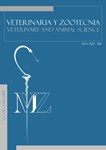Authors
Abstract
The study was developed in the fish culture station “Las Tallas” attached to the Regional Corporation of Cauca, located in the geographic coordinates: latitude 02° 06’ 22” N and longitude 077° 25’ 15.4”W, to an altitude of 670 m.a.s.l, average annual precipitation of 2000 mm, an average temperature of 25.24°C. Thirty six adult fish were evaluated, with an average weight of 217.91±48.14 g and total length of 31.7±2.83 for de female fish, and an average weight of 137.20±13.18 g for the male fish with total length of 26.97±0.86 cm. A completely radom design was used, made up of four treatments distributed in the following way: T0 natural reproduction, T1 5.5 mg/kg of extract of hypophysis (EPC), T2 5 IU/g of Human Corionic Gonadotropin (hCG), and the T3 with 2 IU of hCG/g and 4 mg/kg of EPC. The T0 did not present positive answer. The rest of the treatments were 100% effective in the artificial reproductive process, estimating the hormones effect in relation to the ovulation index, number of oocytes, percentage of fertilization and hatch. Considering the weight as a co- variable in the number of mature oocytes obtained, it was determined that T2 produced a greater amount of ovules (332,602 oocitos/kg) with statistical significance (P<0.05). However, the fertilization and hatching percentages did not present significant differences between T1, T2, T3 treatments, in such a way that the percentage of fertilization was 32% for T1; 31.09% for T2; 32.5% for T3. The hatching percentage was 12% for T1, 9.43% for T2, 11% for T3. As far as the economical analysis is concerned, it was established that treatment T1 registered the best relation cost-profit.
Keywords
References
Baldisserotto, B.; Piaia, R. Densidade de estocagem e crescimento de alevinos do Jundia (Rhamdia quelen). Ciência Rural, v.30, p.6-7, 2000.
Carvajal, M. Inducción a la maduración y desove del róbalo (Centropomus nigrescens) en cautiverio mediante la utilización de hormonas hCG (gonadotropina coriónica humana) y LHRHa (Luteinizing Hormone Releasing Hormone Ethylamide). CENAIM. /Ecuador. Disponible en:
http://www.cenaim.espol.edu. ec/publicaciones/tesisc/ t28.pdf. Accesado en: 15/08/2003.
Cetina, W.; Olaya, N.; Atencio, V.; Segura, A. Análisis cuantitativo del cultivo intensivo del bagre blanco (Sorubim lima, Bloch 1801) en estanques de cemento. In: Congreso suramericano de Acuacultura Memorias del II Congreso Suramericano. Puerto de la Cruz. Venezuela, 1999. p.500.
Junca, V.; Vallejo, F.; Molano, M. Pinilla, G. Fecundidad del tigrito (Pimelodus pictus)(Steindachner, 1876) (Piscis: siluriformes: pimelodidae). Boletín Científico INPA, v.7, p.48, 2002.
López, J. Nutrición Acuícola. 1.ed. Pasto, Colombia: Editorial Universidad de Nariño, 1997. 270p.
Pinto, G.; Jiménez, A. Hábitos alimentarios y vida reproductiva del capitán de la sabana (Eremophilus mutissi) (Pisces) del tramo del río Bogotá en el municipio de Suesca (Cundinamarca). Al Verde Vivo. Bogotá, Colombia, 2003, p.40-48.
Reynalte, D.; Esquivel, B.; Esquivel, J.;Zaniboni, E. Reproducción inducida del Piacu Leporinus macrocephalus (Garavello y Brits, 1988) (Characiformes, Anastomidae). Boletin Do Instituto da pesca, Sao Paulo, Brasil, 2002.18p. Vásquez, F.; Hurtado, H.; López, R.; Bohórquez, P.; Woynarovich, A.; Woynarovich, E. Reproducción artificial de las especies (Colossoma y Piaractus). Fondepes. Lima, Perú, 1998, p.40-42.
Woynarovich, E.; Horváth, L. Propagación artificial de peces de aguas templadas. FAO Roma, Italia, 1981, p.32-40.

 PDF (Español)
PDF (Español)
 FLIP
FLIP










